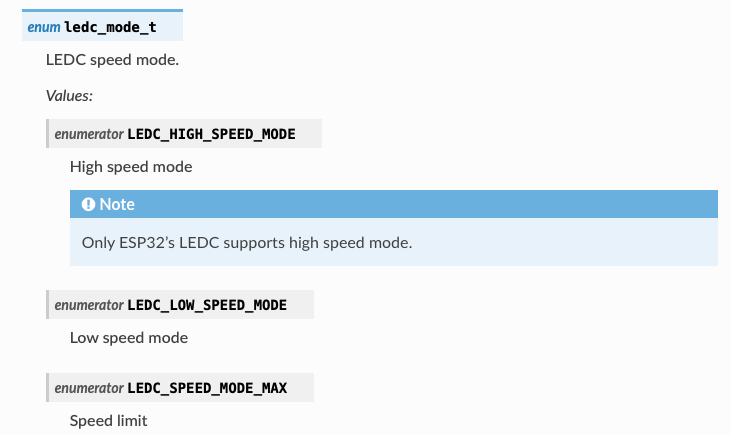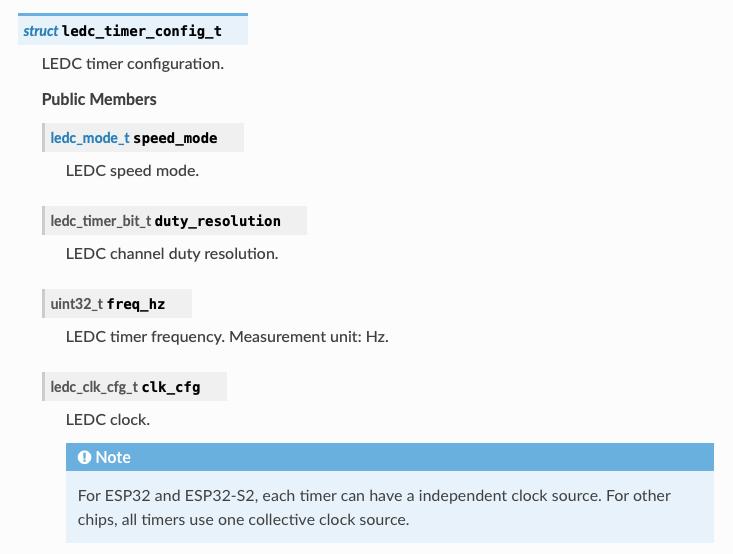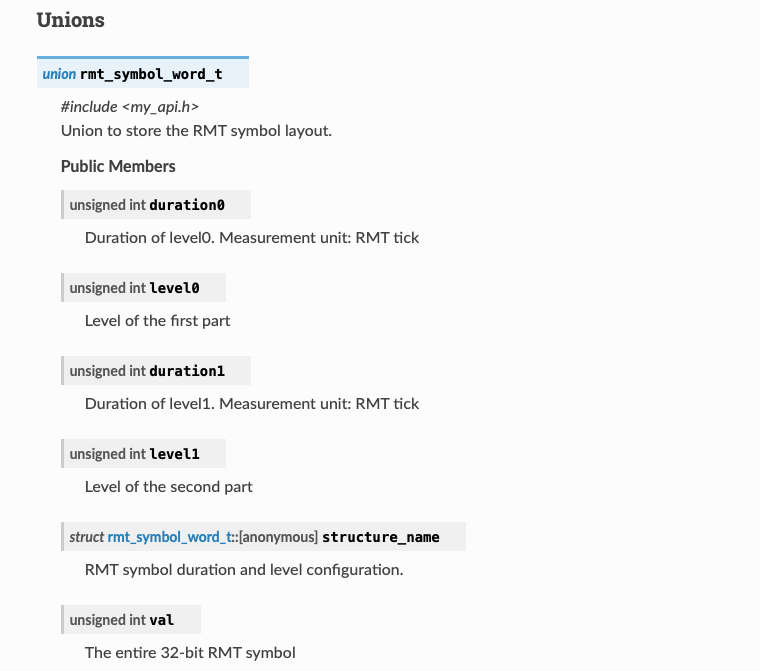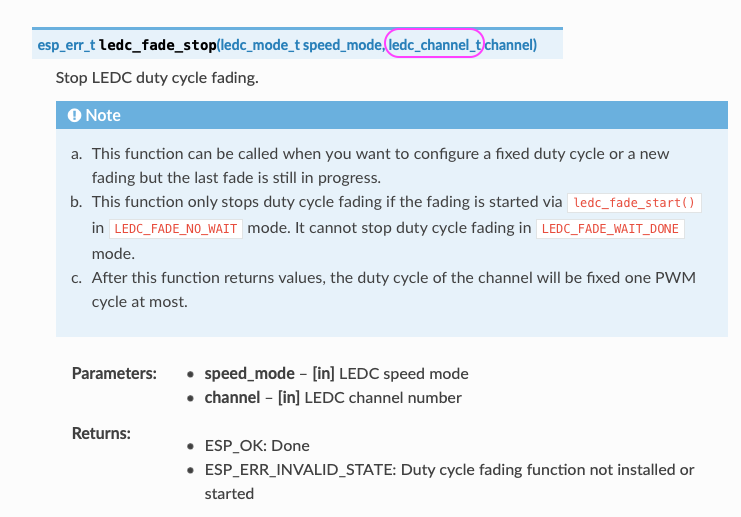Writing API Description
The API descriptions contain all the information required to work with the API, with details about every function, structure, enumeration, and other elements used in the API. To help you write informative API descriptions in a consistent style, this document provides guidelines on what to write with practical examples.
For details about formatting API documentation in header files, please refer to Formatting and Generating API Descriptions.
Document Conventions
This document uses the conventions shown below to indicate types of patterns:
Pattern |
Example |
Identifies |
|---|---|---|
Descriptions enclosed in quotation marks “” |
“Measurement unit: …” |
A fixed sentence pattern for describing measurement unit |
Directives indicated by the @ character |
@brief |
Tags used to define the formatting of the descriptions |
Macro
Macros are used to define reusable values or code snippets, such as a clock frequency, Wi-Fi’s SSID, default configurations, etc.
Macro descriptions should include:
- @brief A brief description of the macro
Use concise sentence fragments if possible
Example: @brief The number of CPU cores.
- @note Target-specific information, or anything that needs emphasis
Example: @note This macro is only for ESP32.
Example 1: ESP_BLUFI_BD_ADDR_LEN
/**
* @brief Bluetooth address length in bytes.
*
* @note Must be 6 bytes.
*/
#define ESP_BLUFI_BD_ADDR_LEN 6
The above code will be rendered as:

Example 2: ESP_NETIF_INHERENT_DEFAULT_OPENTHREAD
/**
* @brief Default configuration of OT ESP-NETIF.
*/
#define ESP_NETIF_INHERENT_DEFAULT_OPENTHREAD() \
{ \
.flags = 0, \
ESP_COMPILER_DESIGNATED_INIT_AGGREGATE_TYPE_EMPTY(mac) \
ESP_COMPILER_DESIGNATED_INIT_AGGREGATE_TYPE_EMPTY(ip_info) \
.get_ip_event = 0, \
.lost_ip_event = 0, \
.if_key = "OT_DEF", \
.if_desc = "openthread", \
.route_prio = 15 \
};
The above code will be rendered as:

Type Definition
Type definitions are used to create a type alias or define a new type.
Type definition descriptions should include:
- @brief A brief description of the typedef
Use concise sentence fragments if possible
Example: @brief Event handler type.
Note
When a type definition is used for function pointers or other similar cases, please refer to the corresponding guidelines for function, etc.
Example: pcnt_unit_handle_t
/**
* @brief PCNT unit handle type.
*/
typedef struct pcnt_unit_t *pcnt_unit_handle_t;
The above code will be rendered as:

Enumeration
Enumerations allow you to define a set of named values (or enumerators) as something textual and meaningful.
Enumeration descriptions should include:
- @brief An overall description of the enumeration
Use concise sentence fragments if possible
Example: @brief Clock sources.
- Meanings of each enumerator
Use concise sentence fragments or sentences
Example: The duty resolution is 13 bits.
- @note Target-specific information, prerequisites to configure a structure member, or anything that needs emphasis
Example: @note The number of channels is different across chips.
Example: ledc_mode_t
/**
* @brief LEDC speed mode.
*/
typedef enum {
LEDC_HIGH_SPEED_MODE = 0, /*!< High speed mode. */
/*!< @note Only ESP32's LEDC supports high speed mode. */
LEDC_LOW_SPEED_MODE, /*!< Low speed mode. */
LEDC_SPEED_MODE_MAX, /*!< Speed limit. */
} ledc_mode_t;
The above code will be rendered as:

Structure
Structures provide a way to group several related data elements (or members) into one place, so that functions can easily use them as parameters. Members in a structure may be of different data types such as int, char, and bool.
Structure descriptions should include:
- @brief An overall description of the structure
Use concise sentence fragments if possible
Example: @brief ESP-NOW rate configuration.
- A list of structure members
- Description of each structure member
Use concise sentence fragments if possible
If the structure member is a
bool, use the format “True if …; false otherwise. “Example: True if the timer interrupts are shared; false otherwise.
“Measurement unit: …”, if any
@note Target-specific information, prerequisites to configure a structure member, or anything that needs emphasis
Example 1: struct esp_ble_mesh_gen_level_set_t
/**
* @brief Generic Level state configuration.
*/
typedef struct {
bool op_en; /*!< True if optional parameters are included; false otherwise. */
int16_t level; /*!< Target value of Generic Level state. */
uint8_t tid; /*!< Transaction ID. */
} esp_ble_mesh_gen_level_set_t;
The above code will be rendered as:

Example 2: struct ledc_channel_config_t
/**
* @brief LEDC timer configuration.
*/
typedef struct {
ledc_mode_t speed_mode; /*!< LEDC speed mode. */
ledc_timer_bit_t duty_resolution; /*!< LEDC channel duty resolution. */
uint32_t freq_hz; /*!< LEDC timer frequency. Measurement unit: Hz. */
ledc_clk_cfg_t clk_cfg; /*!< LEDC clock. */
/*!< @note For ESP32 and ESP32-S2, each timer can have a independent clock source. For other chips, all timers use one collective clock source. */
} ledc_timer_config_t;
The above code will be rendered as:

Union
Similar to structures, unions are also data structures to hold multiple variables, but the members of unions are stored in the same memory locations.
Union descriptions should include:
- @brief An overall description of the union
Use concise sentence fragments if possible
Example: @brief GATT client callback parameters.
- A list of union members with descriptions
- Description of each union member
Use concise sentence fragments if possible
Example: Signal duration.
If the union member is a structure, follow the writing guidelines for structures, that is, provide an overall description for the structure and individual descriptions for structure members. For reference, see line 5 to line 13 in the following example.
“Measurement unit: …”, if any
@note Target-specific information, prerequisites to configure a union member, or anything that needs emphasis
Example: rmt_symbol_word_t
1/**
2* @brief Union to store the RMT symbol layout.
3*/
4typedef union {
5 /**
6 * @brief RMT symbol duration and level configuration.
7 */
8 struct {
9 unsigned int duration0 : 15; /*!< Duration of level0. Measurement unit: RMT tick. */
10 unsigned int level0 : 1; /*!< Level of the first part. */
11 unsigned int duration1 : 15; /*!< Duration of level1. Measurement unit: RMT tick. */
12 unsigned int level1 : 1; /*!< Level of the second part. */
13 } structure_name;
14 unsigned int val; /*!< The entire 32-bit RMT symbol. */
15} rmt_symbol_word_t;
The above code will be rendered as:

Function
Functions encapsulate a set of instructions, and can accept parameters and return values.
Function descriptions should include:
- @brief A brief description of the function
Use concise sentence fragments if possible
Example: Reset the timer.
- Description and direction of parameters
Use concise sentence fragments if possible
If parameters have a measurement unit, remember to mention it with “Measurement unit: …”
Example: PWM frequency. Measurement unit: MHz.
- Returned values and their meanings for non-void functions
If the return value is a
bool, use the format “True if …; false otherwise.”If the return value (especially for functions of the
esp_err_ttype) is a error code such asESP_ERR_INVALID_STATE, provide specific error cause. For example, the description forESP_ERR_INVALID_STATEcan beDuty cycle fading function not installed or started, instead ofInvalid state(see the highlighted line 12 ~ 14 in the example below).
@note Target-specific information, prerequisites to configure a structure member, or anything that needs emphasis
Example: ledc_fade_stop
1/**
2* @brief Stop LEDC duty cycle fading.
3*
4* @note
5* 1. This function can be called when you want to configure a fixed duty cycle or a new fading but the last fade is still in progress.
6* 2. This function only stops duty cycle fading if the fading is started via `ledc_fade_start()` in `LEDC_FADE_NO_WAIT` mode. It cannot stop duty cycle fading in `LEDC_FADE_WAIT_DONE` mode.
7* 3. After this function returns values, the duty cycle of the channel will be fixed one PWM cycle at most.
8*
9* @param[in] speed_mode LEDC speed mode.
10* @param[in] channel LEDC channel number.
11*
12* @return
13* - ESP_OK: Done.
14* - ESP_ERR_INVALID_STATE: Duty cycle fading function not installed or started.
15*
16*/
17esp_err_t ledc_fade_stop(ledc_mode_t speed_mode, ledc_channel_t channel);
The above code will be rendered as:

Note
If a parameter should be assigned with enum values (e.g. values of
ledc_channel_t), there is no need to mention theenumin parameter descriptions given that the link toenumdescriptions will be automatically generated and added (the pink circle in the above Figure).When referring to a function in API descriptions, always add brackets
()after the function. That is,ledc_fade_start(), instead ofledc_fade_start.